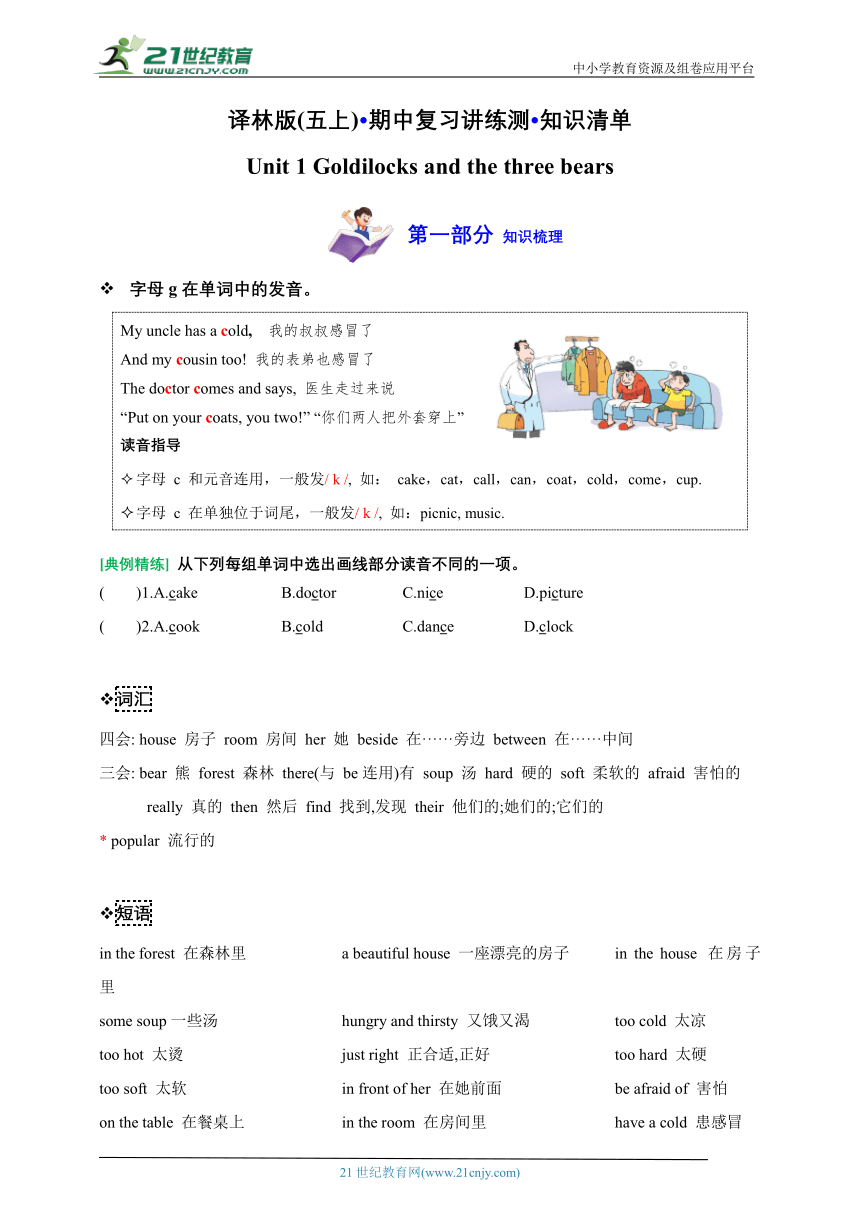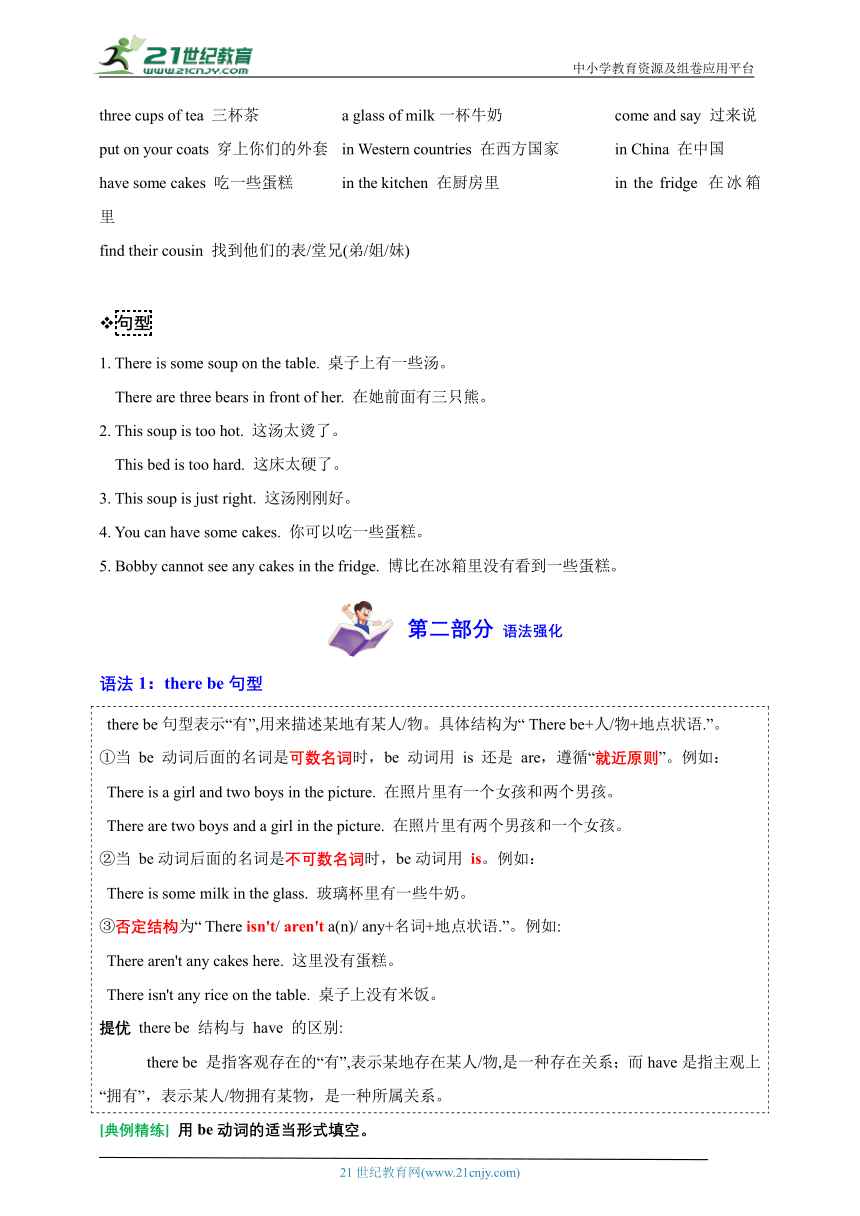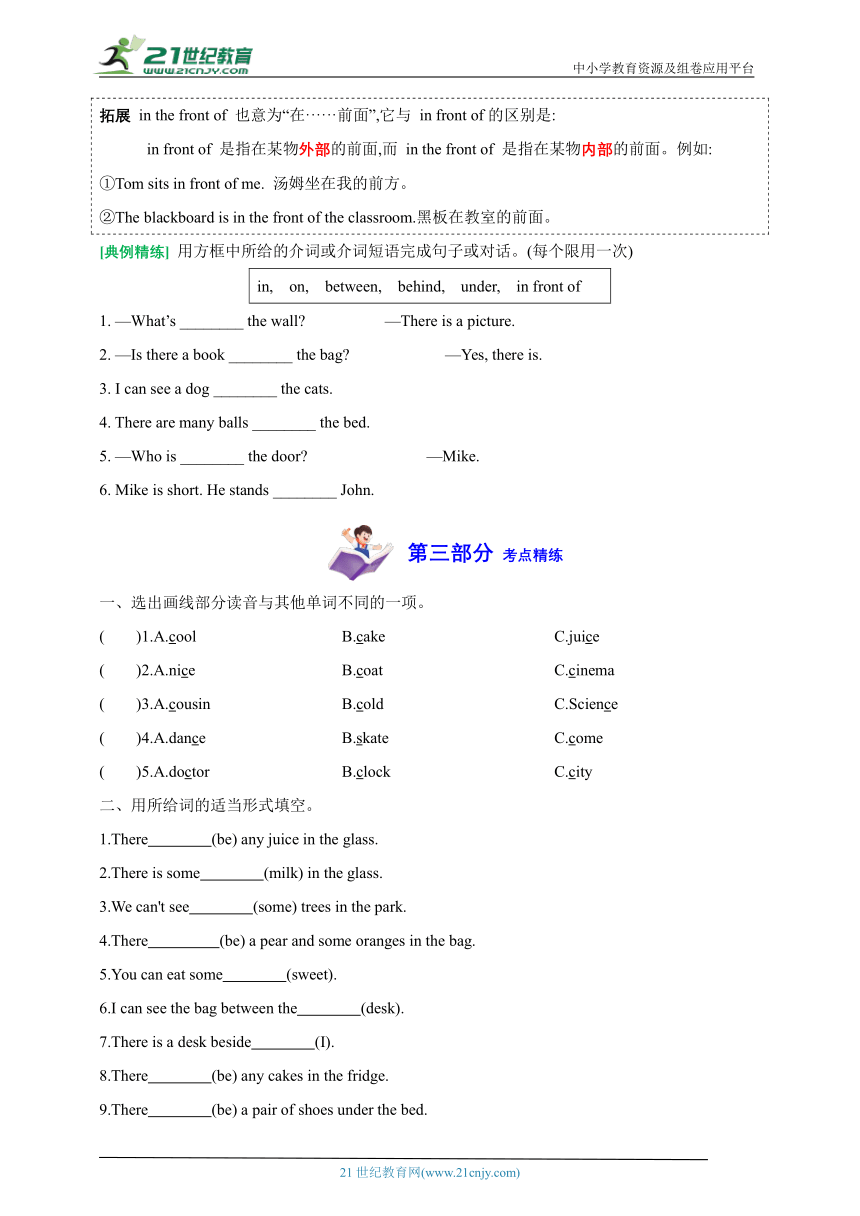Unit 1 Goldilocks and the three bears 知识清单+练习(含答案) -2024-2025学年译林版(三起)五年级上册期中复习讲练测
文档属性
| 名称 | Unit 1 Goldilocks and the three bears 知识清单+练习(含答案) -2024-2025学年译林版(三起)五年级上册期中复习讲练测 |  | |
| 格式 | docx | ||
| 文件大小 | 500.5KB | ||
| 资源类型 | 试卷 | ||
| 版本资源 | 牛津译林版 | ||
| 科目 | 英语 | ||
| 更新时间 | 2024-10-11 10:43:30 | ||
图片预览




文档简介
中小学教育资源及组卷应用平台
译林版(五上) 期中复习讲练测 知识清单
Unit 1 Goldilocks and the three bears
字母g在单词中的发音。
My uncle has a cold, 我的叔叔感冒了 And my cousin too! 我的表弟也感冒了 The doctor comes and says, 医生走过来说 “Put on your coats, you two!” “你们两人把外套穿上” 读音指导 字母 c 和元音连用,一般发/ k /, 如: cake,cat,call,can,coat,cold,come,cup. 字母 c 在单独位于词尾,一般发/ k /, 如:picnic, music.
[典例精练] 从下列每组单词中选出画线部分读音不同的一项。
( )1.A.cake B.doctor C.nice D.picture
( )2.A.cook B.cold C.dance D.clock
词汇
四会: house 房子 room 房间 her 她 beside 在······旁边 between 在······中间
三会: bear 熊 forest 森林 there(与 be连用)有 soup 汤 hard 硬的 soft 柔软的 afraid 害怕的
really 真的 then 然后 find 找到,发现 their 他们的;她们的;它们的
* popular 流行的
短语
in the forest 在森林里 a beautiful house 一座漂亮的房子 in the house 在房子里
some soup一些汤 hungry and thirsty 又饿又渴 too cold 太凉
too hot 太烫 just right 正合适,正好 too hard 太硬
too soft 太软 in front of her 在她前面 be afraid of 害怕
on the table 在餐桌上 in the room 在房间里 have a cold 患感冒
three cups of tea 三杯茶 a glass of milk一杯牛奶 come and say 过来说
put on your coats 穿上你们的外套 in Western countries 在西方国家 in China 在中国
have some cakes 吃一些蛋糕 in the kitchen 在厨房里 in the fridge 在冰箱里
find their cousin 找到他们的表/堂兄(弟/姐/妹)
句型
1. There is some soup on the table. 桌子上有一些汤。
There are three bears in front of her. 在她前面有三只熊。
2. This soup is too hot. 这汤太烫了。
This bed is too hard. 这床太硬了。
3. This soup is just right. 这汤刚刚好。
4. You can have some cakes. 你可以吃一些蛋糕。
5. Bobby cannot see any cakes in the fridge. 博比在冰箱里没有看到一些蛋糕。
语法1:there be句型
there be句型表示“有”,用来描述某地有某人/物。具体结构为“ There be+人/物+地点状语.”。 ①当 be 动词后面的名词是可数名词时,be 动词用 is 还是 are,遵循“就近原则”。例如: There is a girl and two boys in the picture. 在照片里有一个女孩和两个男孩。 There are two boys and a girl in the picture. 在照片里有两个男孩和一个女孩。 ②当 be动词后面的名词是不可数名词时,be动词用 is。例如: There is some milk in the glass. 玻璃杯里有一些牛奶。 ③否定结构为“ There isn't/ aren't a(n)/ any+名词+地点状语.”。例如: There aren't any cakes here. 这里没有蛋糕。 There isn't any rice on the table. 桌子上没有米饭。 提优 there be 结构与 have 的区别: there be 是指客观存在的“有”,表示某地存在某人/物,是一种存在关系;而have是指主观上“拥有”,表示某人/物拥有某物,是一种所属关系。
[典例精练] 用be动词的适当形式填空。
1.There many apples on the tree.
2.There some water and some cakes on the table
3.There any bears in the forest.
4. there any books in the schoolbag
5.There any orange juice in the glass.
语法2:感叹句
感叹句用来表达赞美、惊叹、愤怒、伤心等情感,通常由 what 或 how 引导。 ①以 what引导的感叹句的结构:(其中“主语+谓语”都可以省略) “What+a/ an+形容词+可数名词单数+主语+谓语!”。 例如: What a beautiful house ( it is)!(它是)多么漂亮的一座房子啊! “What+形容词+可数名词复数+主语+谓语!”。 例如:What nice dresses( they are)!(它们是)多么漂亮的连衣裙啊! “What+形容词+不可数名词+主语+谓语!”。 例如:What delicious milk ( it is)! (它是)多么美味的牛奶啊! ②以 how引导的感叹句结构为:“ How+形容词/副词(+主语+谓语)!”。 例如:How beautiful! 多么美丽啊! How cute the cat is! 这只猫多么可爱啊!
[典例精练] 用 What 或 How 填空。
1.________a nice boy!
2.________cute the boy is!
3. ________ cold the milk is!
4.________a beautiful skirt!
5.________ well she skates!
6.________lovely toy animals!
语法3:方位介词
in, on, under, beside, near, between, behind, in front of 注意:①“ between+名词复数”表示“在······之间”; between A and B 表示“在两者之间”。 ②介词后的人称代词须用宾格,例如: behind me, beside him。 拓展 in the front of 也意为“在······前面”,它与 in front of的区别是: in front of 是指在某物外部的前面,而 in the front of 是指在某物内部的前面。例如: ①Tom sits in front of me. 汤姆坐在我的前方。 ②The blackboard is in the front of the classroom.黑板在教室的前面。
[典例精练] 用方框中所给的介词或介词短语完成句子或对话。(每个限用一次)
in, on, between, behind, under, in front of
1. —What’s ________ the wall —There is a picture.
2. —Is there a book ________ the bag —Yes, there is.
3. I can see a dog ________ the cats.
4. There are many balls ________ the bed.
5. —Who is ________ the door —Mike.
6. Mike is short. He stands ________ John.
一、选出画线部分读音与其他单词不同的一项。
( )1.A.cool B.cake C.juice
( )2.A.nice B.coat C.cinema
( )3.A.cousin B.cold C.Science
( )4.A.dance B.skate C.come
( )5.A.doctor B.clock C.city
二、用所给词的适当形式填空。
1.There (be) any juice in the glass.
2.There is some (milk) in the glass.
3.We can't see (some) trees in the park.
4.There (be) a pear and some oranges in the bag.
5.You can eat some (sweet).
6.I can see the bag between the (desk).
7.There is a desk beside (I).
8.There (be) any cakes in the fridge.
9.There (be) a pair of shoes under the bed.
10.My uncle (have) a cold.
三、单项选择。
( )1.________lovely toy bear!
A. How B. What C. What a
( )2. There are some oranges ________the tree. And a bird is singing ________the tree.
A. on; in B. in; on C. in; at
( )3. They ________ see ________ tigers in the zoo.
A. can't; some B. can; any C. cannot; any
( )4.—Lucy is only three years old. Let's go and help ________. —OK.
A. she B. him C. her
( )5.—________ is the bed
—It's ________. I don't like it.
A. What; too soft B. How; too hard C. How; OK
( )6. The girl is ________. She wants to go to bed now.
A. hungry B. thirsty C. tired D. angry
( )7. T ea is popular in ________. Coffee is popular in ________.
A. China; US B. China; Western country C. China; Western countries D. UK;China
( )8.—Would you like ________juice
—No, thanks.
A. any B. some C./ D. a
( )9. Peter thinks Nanjing is his second(第二)________because he lives here for ten years.
A. family B. house C. home D. room
( )10. There is a clock ________ the classroom.
A. in the front of B. in front of C. between D. beside
四、按要求改写句子。
1. The bag is behind the door.(对画线部分提问)
________ the bag
2. There is a bookshelf in the classroom.(对画线部分提问)
________ in the classroom
3. There are three glasses of milk on the table. (改为单数句)
There ________ ________ ________ ________ ________ on the table.
4. There are some boys in the room.(改为否定句)
There ________ ________ ________ ________in the room.
5. We are thirsty and hungry.(改为一般疑问句, 并作肯定回答)
—________ ________ thirsty and hungry
—________, ________ ________.
五、根据中文提示完成句子或对话。
1.桌子上有一些牛奶。
There on the table.
2.树上有五个橙子。
There five oranges the tree.
3.-这个女孩害怕熊吗? -不,她不怕。
- the girl of
-No,she .
4.图画里有一只鸭子和两只鸟。
There a duck and in the picture.
5.这汤太热了。你不能喝它。
The is .You it.
6.迈克和海伦在椅子旁边找到了他们的球。
Mike and Helen ball the chair.
典例精练答案
[语法1]
1. are 2.is 3.isn't 4.Are 5.isn’t
[语法2]
1. What 2. How 3. How 4. What 5. How6. What
[语法3]
1.on 2.in 3.between 4.under 5.behind 6.in front of
考点精练答案
一、1.C 2.B 3.C 4.C 5.C
二、1.isn't 2.milk 3.any 4.is 5.sweets 6.desks 7.me 8.aren't 9.is 10.has
三、1. C 2. A 3. C 4. C 5. B
6. C 解析:女孩很累,所以想去睡觉。故选C。
7. C 解析:根据文化常识可知,茶叶在中国很流行,咖啡在西方国家很流行。country 是可数名词,需要用复数形式。故选C。
8. B 解析:some 在否定或者疑问句中需要变为any,但是在表示“请求”或者“希望得到肯定答复”的句型中, some 不用变。故选B。
9. C 解析: A 选项家庭,B选项房子,C选项家乡,D 选项房间。根据句意可知选C,表示“第二个家乡”。
10. A 解析:in front of 是指在事物外部的前方;in the front of 是指在事物内部的前方;between 是指在两者之间;beside是指旁边。故选 A。
四、1. Where's 2. What's 3. is a glass of milk 4. are not any boys 5. Are you; Yes; we are
五、1.is some milk 2.are,on 3.Is,afraid,bears,isn't
4.is,two birds 5.soup,too hot,can't drink 6.find their,beside
21世纪教育网 www.21cnjy.com 精品试卷·第 2 页 (共 2 页)
21世纪教育网(www.21cnjy.com)
译林版(五上) 期中复习讲练测 知识清单
Unit 1 Goldilocks and the three bears
字母g在单词中的发音。
My uncle has a cold, 我的叔叔感冒了 And my cousin too! 我的表弟也感冒了 The doctor comes and says, 医生走过来说 “Put on your coats, you two!” “你们两人把外套穿上” 读音指导 字母 c 和元音连用,一般发/ k /, 如: cake,cat,call,can,coat,cold,come,cup. 字母 c 在单独位于词尾,一般发/ k /, 如:picnic, music.
[典例精练] 从下列每组单词中选出画线部分读音不同的一项。
( )1.A.cake B.doctor C.nice D.picture
( )2.A.cook B.cold C.dance D.clock
词汇
四会: house 房子 room 房间 her 她 beside 在······旁边 between 在······中间
三会: bear 熊 forest 森林 there(与 be连用)有 soup 汤 hard 硬的 soft 柔软的 afraid 害怕的
really 真的 then 然后 find 找到,发现 their 他们的;她们的;它们的
* popular 流行的
短语
in the forest 在森林里 a beautiful house 一座漂亮的房子 in the house 在房子里
some soup一些汤 hungry and thirsty 又饿又渴 too cold 太凉
too hot 太烫 just right 正合适,正好 too hard 太硬
too soft 太软 in front of her 在她前面 be afraid of 害怕
on the table 在餐桌上 in the room 在房间里 have a cold 患感冒
three cups of tea 三杯茶 a glass of milk一杯牛奶 come and say 过来说
put on your coats 穿上你们的外套 in Western countries 在西方国家 in China 在中国
have some cakes 吃一些蛋糕 in the kitchen 在厨房里 in the fridge 在冰箱里
find their cousin 找到他们的表/堂兄(弟/姐/妹)
句型
1. There is some soup on the table. 桌子上有一些汤。
There are three bears in front of her. 在她前面有三只熊。
2. This soup is too hot. 这汤太烫了。
This bed is too hard. 这床太硬了。
3. This soup is just right. 这汤刚刚好。
4. You can have some cakes. 你可以吃一些蛋糕。
5. Bobby cannot see any cakes in the fridge. 博比在冰箱里没有看到一些蛋糕。
语法1:there be句型
there be句型表示“有”,用来描述某地有某人/物。具体结构为“ There be+人/物+地点状语.”。 ①当 be 动词后面的名词是可数名词时,be 动词用 is 还是 are,遵循“就近原则”。例如: There is a girl and two boys in the picture. 在照片里有一个女孩和两个男孩。 There are two boys and a girl in the picture. 在照片里有两个男孩和一个女孩。 ②当 be动词后面的名词是不可数名词时,be动词用 is。例如: There is some milk in the glass. 玻璃杯里有一些牛奶。 ③否定结构为“ There isn't/ aren't a(n)/ any+名词+地点状语.”。例如: There aren't any cakes here. 这里没有蛋糕。 There isn't any rice on the table. 桌子上没有米饭。 提优 there be 结构与 have 的区别: there be 是指客观存在的“有”,表示某地存在某人/物,是一种存在关系;而have是指主观上“拥有”,表示某人/物拥有某物,是一种所属关系。
[典例精练] 用be动词的适当形式填空。
1.There many apples on the tree.
2.There some water and some cakes on the table
3.There any bears in the forest.
4. there any books in the schoolbag
5.There any orange juice in the glass.
语法2:感叹句
感叹句用来表达赞美、惊叹、愤怒、伤心等情感,通常由 what 或 how 引导。 ①以 what引导的感叹句的结构:(其中“主语+谓语”都可以省略) “What+a/ an+形容词+可数名词单数+主语+谓语!”。 例如: What a beautiful house ( it is)!(它是)多么漂亮的一座房子啊! “What+形容词+可数名词复数+主语+谓语!”。 例如:What nice dresses( they are)!(它们是)多么漂亮的连衣裙啊! “What+形容词+不可数名词+主语+谓语!”。 例如:What delicious milk ( it is)! (它是)多么美味的牛奶啊! ②以 how引导的感叹句结构为:“ How+形容词/副词(+主语+谓语)!”。 例如:How beautiful! 多么美丽啊! How cute the cat is! 这只猫多么可爱啊!
[典例精练] 用 What 或 How 填空。
1.________a nice boy!
2.________cute the boy is!
3. ________ cold the milk is!
4.________a beautiful skirt!
5.________ well she skates!
6.________lovely toy animals!
语法3:方位介词
in, on, under, beside, near, between, behind, in front of 注意:①“ between+名词复数”表示“在······之间”; between A and B 表示“在两者之间”。 ②介词后的人称代词须用宾格,例如: behind me, beside him。 拓展 in the front of 也意为“在······前面”,它与 in front of的区别是: in front of 是指在某物外部的前面,而 in the front of 是指在某物内部的前面。例如: ①Tom sits in front of me. 汤姆坐在我的前方。 ②The blackboard is in the front of the classroom.黑板在教室的前面。
[典例精练] 用方框中所给的介词或介词短语完成句子或对话。(每个限用一次)
in, on, between, behind, under, in front of
1. —What’s ________ the wall —There is a picture.
2. —Is there a book ________ the bag —Yes, there is.
3. I can see a dog ________ the cats.
4. There are many balls ________ the bed.
5. —Who is ________ the door —Mike.
6. Mike is short. He stands ________ John.
一、选出画线部分读音与其他单词不同的一项。
( )1.A.cool B.cake C.juice
( )2.A.nice B.coat C.cinema
( )3.A.cousin B.cold C.Science
( )4.A.dance B.skate C.come
( )5.A.doctor B.clock C.city
二、用所给词的适当形式填空。
1.There (be) any juice in the glass.
2.There is some (milk) in the glass.
3.We can't see (some) trees in the park.
4.There (be) a pear and some oranges in the bag.
5.You can eat some (sweet).
6.I can see the bag between the (desk).
7.There is a desk beside (I).
8.There (be) any cakes in the fridge.
9.There (be) a pair of shoes under the bed.
10.My uncle (have) a cold.
三、单项选择。
( )1.________lovely toy bear!
A. How B. What C. What a
( )2. There are some oranges ________the tree. And a bird is singing ________the tree.
A. on; in B. in; on C. in; at
( )3. They ________ see ________ tigers in the zoo.
A. can't; some B. can; any C. cannot; any
( )4.—Lucy is only three years old. Let's go and help ________. —OK.
A. she B. him C. her
( )5.—________ is the bed
—It's ________. I don't like it.
A. What; too soft B. How; too hard C. How; OK
( )6. The girl is ________. She wants to go to bed now.
A. hungry B. thirsty C. tired D. angry
( )7. T ea is popular in ________. Coffee is popular in ________.
A. China; US B. China; Western country C. China; Western countries D. UK;China
( )8.—Would you like ________juice
—No, thanks.
A. any B. some C./ D. a
( )9. Peter thinks Nanjing is his second(第二)________because he lives here for ten years.
A. family B. house C. home D. room
( )10. There is a clock ________ the classroom.
A. in the front of B. in front of C. between D. beside
四、按要求改写句子。
1. The bag is behind the door.(对画线部分提问)
________ the bag
2. There is a bookshelf in the classroom.(对画线部分提问)
________ in the classroom
3. There are three glasses of milk on the table. (改为单数句)
There ________ ________ ________ ________ ________ on the table.
4. There are some boys in the room.(改为否定句)
There ________ ________ ________ ________in the room.
5. We are thirsty and hungry.(改为一般疑问句, 并作肯定回答)
—________ ________ thirsty and hungry
—________, ________ ________.
五、根据中文提示完成句子或对话。
1.桌子上有一些牛奶。
There on the table.
2.树上有五个橙子。
There five oranges the tree.
3.-这个女孩害怕熊吗? -不,她不怕。
- the girl of
-No,she .
4.图画里有一只鸭子和两只鸟。
There a duck and in the picture.
5.这汤太热了。你不能喝它。
The is .You it.
6.迈克和海伦在椅子旁边找到了他们的球。
Mike and Helen ball the chair.
典例精练答案
[语法1]
1. are 2.is 3.isn't 4.Are 5.isn’t
[语法2]
1. What 2. How 3. How 4. What 5. How6. What
[语法3]
1.on 2.in 3.between 4.under 5.behind 6.in front of
考点精练答案
一、1.C 2.B 3.C 4.C 5.C
二、1.isn't 2.milk 3.any 4.is 5.sweets 6.desks 7.me 8.aren't 9.is 10.has
三、1. C 2. A 3. C 4. C 5. B
6. C 解析:女孩很累,所以想去睡觉。故选C。
7. C 解析:根据文化常识可知,茶叶在中国很流行,咖啡在西方国家很流行。country 是可数名词,需要用复数形式。故选C。
8. B 解析:some 在否定或者疑问句中需要变为any,但是在表示“请求”或者“希望得到肯定答复”的句型中, some 不用变。故选B。
9. C 解析: A 选项家庭,B选项房子,C选项家乡,D 选项房间。根据句意可知选C,表示“第二个家乡”。
10. A 解析:in front of 是指在事物外部的前方;in the front of 是指在事物内部的前方;between 是指在两者之间;beside是指旁边。故选 A。
四、1. Where's 2. What's 3. is a glass of milk 4. are not any boys 5. Are you; Yes; we are
五、1.is some milk 2.are,on 3.Is,afraid,bears,isn't
4.is,two birds 5.soup,too hot,can't drink 6.find their,beside
21世纪教育网 www.21cnjy.com 精品试卷·第 2 页 (共 2 页)
21世纪教育网(www.21cnjy.com)
